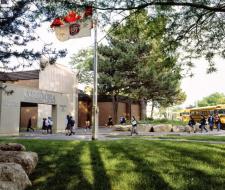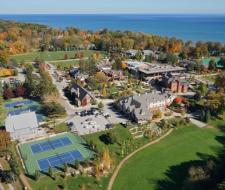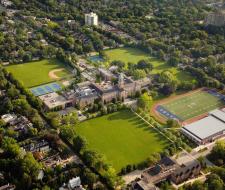48 best private schools in Toronto, Ontario 2026
- Advantages of schools in Toronto
- Schools in Toronto: Disadvantages and features
- Preschool education in Ontario
- School education in Toronto
- Levels of secondary education in Toronto
- Grading system in Canadian schools
- Public, alternative, and private schools in Toronto
- How to enroll children in a school in Toronto?
- History of secondary education in Ontario
- Literature and references
This content was developed and approved with active participation of Nadya Shupta.
In the process of preparing the material, we referenced the following sources:
- https://en.wikipedia.org/wiki/Education_in_Toronto
- https://medium.com/@obiyan/what-is-the-most-expensive-private-school-in-toronto-805ce9d29ad8
-
 100 % University placement from each graduating class
100 % University placement from each graduating class CanadaToronto, OntarioCurrently watching: 8from 74355.00 $CAD / year
CanadaToronto, OntarioCurrently watching: 8from 74355.00 $CAD / year -
 65 sport and clubs in PC's co-curriculum program
65 sport and clubs in PC's co-curriculum program CanadaToronto, OntarioCurrently watching: 9from 475.00 $CAD / week
CanadaToronto, OntarioCurrently watching: 9from 475.00 $CAD / week -
 CIC has more top universities in the partnership program than any other school
CIC has more top universities in the partnership program than any other school CanadaToronto, OntarioCurrently watching: 7from 26400.00 $CAD / 10 months
CanadaToronto, OntarioCurrently watching: 7from 26400.00 $CAD / 10 months -
 100 % University placement from each graduating class
100 % University placement from each graduating class CanadaToronto, OntarioCurrently watching: 8from 26200.00 $CAD / term
CanadaToronto, OntarioCurrently watching: 8from 26200.00 $CAD / term -
 from 5990.00 $CAD / 4 weeks
from 5990.00 $CAD / 4 weeks -
 100 % University placement from each graduating class
100 % University placement from each graduating class CanadaToronto, OntarioCurrently watching: 7from 437.00 $CAD / week
CanadaToronto, OntarioCurrently watching: 7from 437.00 $CAD / week -
 In 2022 - 82.5% of Advanced Placement students achieved the top grade of 3
In 2022 - 82.5% of Advanced Placement students achieved the top grade of 3 CanadaToronto, OntarioCurrently watching: 9from 34250.00 $CAD / semester
CanadaToronto, OntarioCurrently watching: 9from 34250.00 $CAD / semester -
 According to the results for 2023, 36% of graduates enrolled in the University of Toronto
According to the results for 2023, 36% of graduates enrolled in the University of Toronto CanadaToronto, OntarioCurrently watching: 5from 29800.00 $CAD / year
CanadaToronto, OntarioCurrently watching: 5from 29800.00 $CAD / year -
 In 2023 100% graduates achieved Ontario Secondary School Diploma (OSSD)
In 2023 100% graduates achieved Ontario Secondary School Diploma (OSSD) CanadaToronto, OntarioCurrently watching: 5from 1200.00 $CAD / month
CanadaToronto, OntarioCurrently watching: 5from 1200.00 $CAD / month -
 from 34135.00 $CAD / year
from 34135.00 $CAD / year
A Guide to Toronto’s Private Schools for Foreign Students
In Toronto, Ontario, private schools offer a rich tapestry of educational opportunities. Catering to around 6.8% of all students in Canada, these institutions range from single-sex and faith-based educational institutions to those tailored for children with disabilities or exceptional talents. Whether your child is artistically inclined, athletically gifted, or intellectually curious, Toronto's private schools provide an environment where these traits can flourish.
Toronto's private schools are diverse in their focus and pedagogy. From specialized programs like horse riding, skiing, or even speleology, to teaching methods inspired by Montessori or Waldorf, the city's private schools cater to a wide array of interests and learning styles. Some educational institutions adopt an experimental approach, while others maintain a more traditional or structured environment. For students looking to immerse themselves in a new language, certain schools offer complete instruction in a foreign language.
Location Variety in Toronto’s Private Schools
Parents can choose educational institutions nestled in the natural landscapes of Western provinces or those in the vibrant, culturally rich streets of Toronto. Many of these schools are boarding schools, ensuring a convenient and comfortable living experience close to academic facilities. Advanced Placement courses are common, preparing students for easy transition to universities in Canada or the United States.
Key features in Toronto’s Private Schools
Private schools in Toronto operate similarly to public schools, but with varied curricula and teaching styles. The daily schedule typically runs Monday through Friday, starting from 8:30 am or 9:00 am and ending between 2:30 pm and 4:00 pm. Students often have four to five classes per day, each lasting about 70-80 minutes, and enjoy a lunch break that spans the duration of a class. Additionally, there are usually two 15-minute breaks between classes. Some boarding schools may offer optional Saturday classes.
The academic year in Canada generally spans ten months, from early September to late June, and is divided into semesters. Some schools operate year-round, and vacation dates are usually announced well in advance.
Private Schools in Toronto. Cost and Fees
Tuition fees vary based on the chosen educational institutions type. Public school enrollment for high school students typically costs between 12,000 to 14,000 Canadian dollars per year, excluding host family accommodation. Full-time education at a private school in Toronto can reach up to 23,000 Canadian dollars annually. For a full board option, parents should anticipate costs ranging from 35,000 to 45,000 Canadian dollars per year.
While public schools generally accept foreign students aged 12 and above, younger children (ages 9-10) often find opportunities at private schools offering full-board education. This makes private schools a viable option for families seeking early enrollment.

What does make Canadian schools special? Why do parents from all over the world choose Canada primary and secondary schools for their children?
First of all, it is a high level of education, which is recognized throughout the world. Canada is the most educated country on the planet, so the culture of education is at the highest level here. All schools in Canada - public, private, independent - follow a provincial curriculum, and all educators are required to hold a teaching degree and certification. All these factors convince families that no matter which school they choose, their children will receive a first-class education.
Alternative destinations
Advantages of schools in Toronto
Good funding
Much of the cost is covered by budget subsidies: the OECD estimates that an average of 6% of GDP is spent on education, and in Ontario it can be as high as 12%, a multiple of other OECD member countries.
Value for money
All private and international schools are accredited, which confirms that they meet high quality standards. At the same time, tuition fees are lower than in Australia, the UK and the USA.
Multiculturalism
All residents of Canada are either migrants or their heirs, so the attitude to foreigners is friendly. In 2020, more than half a million expats entered the country to study.
Flexible visa policy
Applying for a visa to Canada is easy: all you need to do is create an IRCC account and upload all the necessary documentation, then wait for a decision.
Hospitality
Expats in Canada never feel like outsiders: Canada has one of the most foreigner-friendly education systems in the world and welcomes people from all corners of the globe. As well as studying, expats have access to a wide range of cultural, recreational and leisure activities to help them broaden their horizons and make new acquaintances.
Small class sizes
Classes in public schools do not exceed 25 students, while the norm for private schools is between 5 and 15 students.
Bilingualism
Toronto students can choose to study programs in one of Canada's official languages, English or French. A number of schools offer blended learning, although most schools consider English to be the primary language. Regardless of the choice of primary language, a second language is taught in the lower grades.
Schools in Toronto: Disadvantages and features
Bilingualism
Bilingualism can be both an advantage and a disadvantage. In Ontario, there are schools with English or French as the primary language, so choosing an educational institution requires great attention and thoroughness. Some schools offer mixed English-French instruction, which can be an excellent option if the child is prepared for such a workload.
Humid Climate
Average temperatures in Ontario are generally comfortable, though winter can bring quite low temperatures. Summers in Toronto can be humid and muggy, although the proximity of the Great Lakes and Antarctic waters prevents the temperature from reaching extreme levels.
High Workload
The highest standards of education make studying a challenging task: students face large and complex homework assignments, regular tests, and independent projects. During exam periods, they often work late at night.
Preschool education in Ontario
In Ontario, kindergarten programs are supported by provincial and federal governments, as well as private organizations and non-profit organizations. Children are permitted to enroll in kindergarten for two years, beginning at the age of four, but participation is not mandatory, leading to a wide variation in the number, intensity, and frequency of classes.
The key feature of preschool education in Ontario, particularly in Toronto, is its adaptability, focusing on fulfilling the individual needs of each child. Young learners are introduced to reading and basic math, while also engaging in activities like sculpting and drawing to enhance their artistic skills. Additionally, they participate in dancing, singing, and playing instruments, with a strong emphasis on a play-centered learning approach.
Some private kindergartens accept children from 18 months. These programs require tuition fees ranging from 400 to 1300 CAD monthly.
Statistics indicate that children who attend kindergarten attain academic results that are 27% superior compared to those who do not participate.
School education in Toronto
Education in Ontario is compulsory, universal, and free until the age of 18. Students attend school six days a week.
The province features four public school systems: public schools offering instruction in either English or French, and separate school systems providing English or French education, primarily for the Catholic community, although anyone can enroll. There is one Protestant school located in Penetanguishene.
Levels of secondary education in Toronto
Elementary School (grades 1-8)
Divided into 3 phases:
Elementary schools (grades 1 to 3)
Children are required to attend elementary schools in Ontario from the age of six. Students are taught in a single classroom with a classroom teacher.
The curriculum at this stage includes such disciplines:
- arithmetic and science;
- social studies;
- reading and literature;
- history;
- geography;
- English/French as a first language;
- music;
- art;
- sports.
Junior school (grades 4 through 6)
The program is becoming more complex. A second national language is added.
Senior school (Senior school, 7th-8th grade)
The middle school stage lasts for 2 years. In the 7th grade children begin to attend lessons with subject teachers. The main goal of this stage is to create a holistic picture of the world in the child's mind, to prepare him or her for high school. Pupils continue to study the subjects they already know from primary grades. A second state language is added to the program, and in some cases a foreign language is added.
High School (grades 9-12)
This is a four-year program for adolescents 14-17 years old, from 8th to 12th grade inclusive. The strategic goal of this stage is to equip children with the skills necessary for professional self-actualization and to prepare them for higher education. In addition, secondary schools may offer special programs with academic or professional orientation.
92% of public schools and at least 70% of private schools follow the Ontario Curriculum, which allows for some flexibility in delivery methods, but clearly outlines the requirements for student knowledge and behavior.
The grade 9-10 curriculum is divided into three streams: academic, basic and applied:
- The first stream is the prerogative of students intending to attend university,
- Applied courses will lead graduates to college,
- The basic course is designed for students with special educational needs.
In recent years, there has been an increasing number of voices calling for the abolition of streams in grades 9 and 10 to give students more time to choose their future development path.
The 11th and 12th grade curriculum is also divided into 3 streams - university, college and career preparation courses, respectively. Regardless of the major, they are designed to develop critical thinking and soft skills needed later in life. Academic courses focus more on abstract thinking and encourage students to be more independent in their judgments and conclusions. College preparatory courses focus on the practical application of knowledge in everyday life, while vocational courses are characterized by a more practice-oriented, “down-to-earth” approach.
Each stream is evaluated in its own way, taking into account the specifics and special requirements of the educational process: an 85% English score in a college preparatory stream is considered a good indicator, but will not be sufficient for university admission - the student will have to either get a higher score in exams or take internal entrance exams.
Grading system in Canadian schools
Three different models are equally used to assess students' academic performance:
- Letter grading;
- Percentage grading;
- GPA.
Grades are assigned for tests, independent work, projects, and exams across various subjects.
The letter scale ranges from A to F, with F being the lowest grade. To provide more accuracy, plus and minus modifiers are used, denoted by "+" or "-" signs. For instance, an A+ is equivalent to 95-100%, while an A- corresponds to 85-90%.
Students receive a Report Card every quarter, sealed in an envelope to ensure privacy. This report includes comprehensive information about academic progress and a personal evaluation of the student's qualities, such as organizational, communication, and social skills. A four-point scale is used for assessment:
- E — Excellent;
- G — Good;
- S — Satisfactory;
- N — Needs Improvement.
When preparing the Report Card, teachers draw on their experience working with each student individually and in group settings. These reports are designed to help parents optimize their child's academic workload.
Public, alternative, and private schools in Toronto
Ontario's public education system includes more than 4,000 public schools with 1.4 million students and 850 private schools with nearly 700,000 students.
Toronto Public Schools
Toronto Public Schools consist of two distinct educational systems: one for English speakers, comprising 600 schools, and another for French speakers, which includes 36 elementary and secondary institutions overseen by a single school board. Both systems provide free education to local residents from kindergarten through grade 12.
The Francophone education system aims to protect and enhance French culture, delivering lessons solely in French. Enrollment is automatically granted to children whose parents' first language is French, those who have attended a French school, or siblings who are students in French schools. Other applications are assessed by the school board.
French immersion programs are offered within English-speaking schools, where subjects are taught in both languages. The public school curricula for English and French differ; for instance, grades 1-8 in English include eight subjects, while the French program covers eleven. In higher grade levels, 19 subjects are taught in English compared to 21 in French, in addition to over 300 specialty courses available in both languages.
Catholic schools in Toronto
Toronto also features two Catholic education systems—English and French. They are independently run but have public funding. Admission is open to students from Catholic families, while other denominations may be considered at the school board's discretion. The Toronto Catholic District School Board (TCDSB) is recognized as the largest Catholic school board financed by public funds globally.
Toronto private schools
Private schools in Toronto serve around a quarter of Ontario's students, with an even higher percentage in the city. Though independent of the provincial Ministry of Education, they must comply with the Ontario curriculum. Tuition ranges from 4,000 to 80,000 CAD per year, and families typically choose schools based on teaching methods, religious affiliations, or other values. Approximately 62% of private institutions in the region are coeducational.
Toronto is also home to a number of denominational elementary and secondary schools, including:
- 11 Protestant;
- 1 Hindu;
- 18 Muslim;
- 15 Jewish.
Home schooling
Home schooling accounts for fewer than 1% of families in Ontario, utilizing either parent-led education or guest instructors. The government offers free EQAO tests in grades 3, 6, and 9, as well as literacy assessments in grade 10 to these home-schooled children.
How to enroll children in a school in Toronto?
To begin selecting a suitable school, use the school information search system, which is a governmental tool that helps identify elementary and secondary schools in the vicinity where you intend to reside. Subsequently, explore the website of the local school board for public or Catholic institutions, or directly access the specific school's site if you are interested in a private school. The application must be completed and submitted via a designated section, as there isn't a centralized application processing system.
The application requires details about the child, including the home address, medical information, and contact numbers. Additionally, it’s necessary to provide copies of the child's identification, vaccination history, and relevant documents from any previous schools attended (such as transcripts, report cards, and other documents mandated by the school).
History of secondary education in Ontario
The first learning institutions in Upper Canada were founded in the early 1800s. The Grammar Schools Act, enacted in 1807, provided financial support for the creation of eight new schools. In 1823, the General Board of Education was established, and the following year, the funds were used to establish Sunday schools in rural areas.
The Mohawk Institute, which holds the distinction of being Canada's longest-operating residential school, was opened in 1834. The unification of Upper and Lower Canada in 1841 ignited a considerable debate regarding educational philosophies between Catholic and Protestant communities. Upper Canada, later renamed Western Canada and ultimately Ontario, was mainly Protestant, whereas Lower Canada was primarily Catholic. This continued dispute resulted in the development of two distinct educational structures within the province, a separation that lasted until 1867, when the provinces united and Ontario gained self-governance. The British North America Act protected the educational rights of religious minorities, but it did not ensure similar safeguards for French-speaking minorities or other linguistic groups.
The Common Schools Act of 1850 transferred the responsibility of funding secondary education to local administrations, granting school boards the power to either implement or eliminate tuition fees at their discretion. This legislation also cleared the way for the establishment of publicly funded Catholic schools.
In the same period, racial segregation became legal, with Ontario and Nova Scotia standing out as provinces where it was officially permitted. The government’s justification was that institutions could better serve specific religious and ethnic groups. In practice, however, African Americans became the most segregated population in Ontario, this separation continued until 1965, when the last racially segregated school was closed.
Currently, residential schools for Indigenous children were established. These schools were managed by the federal governments, which relieved provincial governments from their treaty obligations to Indigenous tribes. These schools were known for maltreatment and violence. Although Indigenous residential schools still function today, they have been reformed and are supported by ongoing federal funding.
In 1871, free mandatory education was introduced for children up to the age of 12, separating into elementary schools and collegiate institutes akin to traditional grammar schools. By 1891, education was compulsory until age 14, later extended to 16 in 1921, with exemptions for working students. Since 1970, this requirement has applied to all children.
The Ontario Academic Credit system was implemented in 1984. By 1990, all provincial schools became secular, with the province assuming responsibility and religious colleges transitioning to universities. In 1997, education funding was transferred from municipal to provincial administration.
Top 17 best private schools in Toronto 2026
| 1 | St Andrew's College |
| 2 | Branksome Hall School |
| 3 | Columbia International College |
| 4 | Rosseau Lake College |
| 5 | Braemar College boarding school |
| 6 | Trafalgar Castle School |
| 7 | McDonald International Academy MIA |
| 8 | Bronte college |
| 9 | Trinity College School |
| 10 | Upper Canada College Private Boarding School |
| 11 | Havergal College |
| 12 | Metropolitan Preparatory Academy Boarding School |
| 13 | Bond Academy |
| 14 | George Brown College Toronto |
| 15 | Princeton Academy Canada Private School |
| 16 | William Academy Private School |
| 17 | Victoria International Ballet Academy |
Advantages and disadvantages of English schools
| Advantages | Disadvantages |
|---|---|
| The opportunity to enter the best universities in England, USA, Canada, Switzerland, Europe, the world | Expensive |
| High quality of education and academic standards | Strong workload |
| Perfect English after graduation | The need to change the social environment; it takes time to adapt |
| Useful contacts | The difficulty of choosing the most suitable school for the child, requires a qualified specialist |
Top 35 best schools in the USA - 2026 Smapse rankings
| 1 | North Broward Preparatory School |
| 2 | Phillips Academy Andover |
| 3 | The Storm King School New York |
| 4 | Red Bank Catholic High School |
| 5 | Windermere Preparatory School |
| 6 | Shattuck St Mary's School |
| 7 | Cheshire Academy |
| 8 | Cate School |
| 9 | Ross School |
| 10 | Deerfield Academy |
| 11 | The Village School |
| 12 | Amerigo Los Angeles – Bishop Montgomery High School |
| 13 | Webb Schools |
| 14 | Kent School USA |
| 15 | The Winchendon School |
| 16 | Darlington School |
| 17 | Marian Catholic High School Amerigo Education |
| 18 | Grier School |
| 19 | The MacDuffie School |
| 20 | CATS Academy Boston |
| 21 | The Cambridge School of Weston |
| 22 | Milton Academy |
| 23 | Amerigo Education Napa Valley |
| 24 | American Hebrew Academy |
| 25 | Northfield Mount Hermon School |
| 26 | Mater Dei Catholic High School San Diego Amerigo Education |
| 27 | American University Preparatory School Los Angeles |
| 28 | Webb Schools |
| 29 | Kent School USA |
| 30 | Groton School |
| 31 | Maine Central Institute |
| 32 | The Lawrenceville School |
| 33 | Grand River Academy Ohio |
| 34 | Saint John Paul II Academy |
| 35 | Chicago North Shore |
Top 14 best schools in Switzerland 2026
| 1 | College Du Leman |
| 2 | St. Georges School Montreux |
| 3 | Institut Monte Rosa |
| 4 | Lyceum Alpinum Zuoz |
| 5 | Saint-Charles Collège et Lycée |
| 6 | Leysin American School |
| 7 | Hochalpines Institut Ftan AG High Alpine |
| 8 | Aiglon College Switzerland |
| 9 | Institut Le Rosey School |
| 10 | Institut Montana Zugerberg |
| 11 | Champittet College |
| 12 | Brillantmont International School |
| 13 | Surval Montreux |
| 14 | Ecole Pre Fleuri |
Literature and references
-
Education in Toronto — Wiki
-
List of Toronto District School Board elementary schools — Wiki
-
List of secondary schools in the Toronto District School Board — Wiki
-
Education in Canada
-
Which city in Ontario has the best elementary schools?
-
What is the most expensive private school in Toronto?
-
Private schools in Toronto — Wiki
-
Best private schools in Toronto
